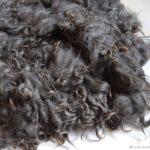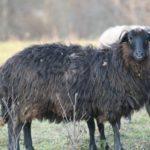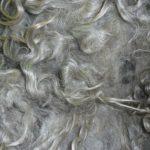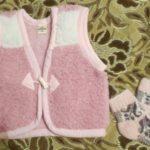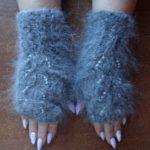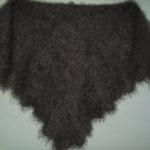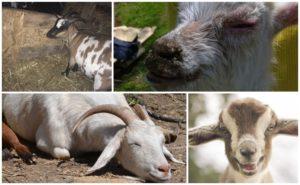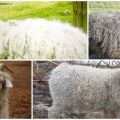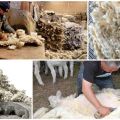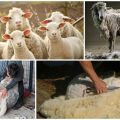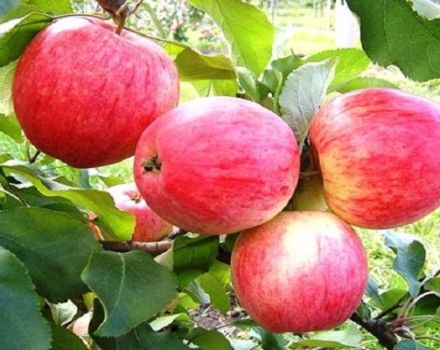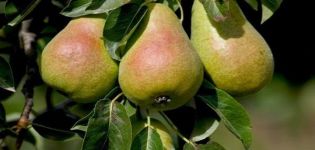Advantages and disadvantages of goat hair, classification and where it is applied
Goat fluffy wool by nature itself was created for the good of man. Soft, warm clothing protects from severe frosts, heals sore joints and helps to cope with colds. In terms of its qualities, the material is superior to sheep vegetation. It is characterized by elasticity, smoother and more uniform structure. Things knitted from the down of a horned pet serve for many years without losing their original appearance.
Features of goat hair
The chemical composition of goat down is unique - the vegetation consists of protein substances (keratin and fibroin). This means that animal hair contains such valuable components as sulfur, nitrogen, hydrogen, carbon and oxygen.
Goat hair consists of 3 components:
- Coarse, thickened guard hair. Rigid fibers define the volume and overall structure of the fur, and also serve as protection from external environmental influences.
- Transitional hairs. They are much thinner than the guard "brothers".
- Short, soft down. Delicate, thin, crimped fiber.
Hair scales are securely attached to the cortex. This feature makes the animal's coat shiny and silky. The main criterion for fiber quality is hair thickness (fineness). It is measured in micrometers. The length, curvature and strength of the hairs are of great importance.
The complex structure of the coat provides the animal with protection from heat and frost. Different sized hairs create numerous air bags - pockets. Traps trap air at the surface of the pet's body, so goats do not suffer from freezing or overheating.

The material is able to absorb a large amount of moisture and immediately give it out. This property allows the animal to keep warm even when wet. Certain varieties of wool and fluff are distinguished by a hollow, tubular hair structure, therefore, they have the best thermal insulation qualities.
Advantages and disadvantages
Goat hair is known for its healing and warming qualities, but the use of the material is not suitable for everyone.
Classification and characteristics of the breed of animals
Orenburg, Kashmir and Angora breeds are most often used as suppliers of down and wool.
According to technical characteristics, the material is divided into groups:
- Uniform wool (mohair or angora). Exceptionally strong, semi-rough, shiny and silky. Angora wool is characterized by a snow-white color. The material is readily used in the textile industry. Wool serves as a raw material for high quality suit and drape fabrics.
- Irregular or mixed goat hair. Such material is obtained from any animal species, with the exception of the Angora goat. The coarse, blended coat includes guard, transitional and delicate down hairs. Such material is used for the manufacture of carpets and dense felted products.
- Pure fluff. The material is obtained from the Kashmir and Orenburg goat breeds. Even light merino wool cannot be compared with the tenderness and fineness of the hairs of goat down. Silky material is obtained by combing animals. Down quality varies. The material is divided into 3 categories: coarse angora (the densest down - 30 microns), cashmere (thinner - 23 microns), cashmere (the lightest - 19 microns).
In addition to the technical classification, goat hair is classified by color (white, light gray, colored, black). The color of the uneven, coarse coat is not determined.

According to the state, the material is divided into 2 categories:
- Weedy, cheap wool. This group includes strands with a large amount of impurities (more than 3%).
- Normal stuff. Used for expensive products.
Application area
The high cost of down products often confuses buyers and forces them to purchase things made of polyester materials. This is reflected in the production of knitted products. However, no artificial substitutes can match the unique properties of goat down.
Felt products (hats, slippers, felt boots), side fabric, all kinds of rollers and brushes, drive belts and other elements for mechanisms are produced from a mixed, coarse material.
Coats, hats, cardigans, stoles and even soft toys are knitted from high-quality mohair. Dense mohair is used to make great rugs and blankets. Due to the purity of the material, the products are recommended for babies. Weightless, warm shawls are knitted from the down of Orenburg goats. The advocates of a healthy lifestyle advise using undyed yarn. This material retains its unique antibacterial properties.
Features of knitting with wool yarn with fluff
For knitting, soft goat down is used, connected with cotton, linen or slippery silk thread. It is not recommended to use a hook for work. In this case, the web comes out too rough. When knitting, the product is uniform and soft. The diameter of the knitting needles should be taken a little more than that for such a thickness of yarn. For working with yarn from goat down, you should not choose complex openwork patterns.
Material care rules
Warm woolen products need delicate and gentle care.Clothes are washed by hand, at a water temperature not exceeding 30 degrees. In some cases, it is allowed to wash woolen things in a machine, if there is a special program in it.
Before the procedure, the clothes are turned inside out. For washing, use special detergents for woolen products. Dry clothes by spreading them out on a table or any flat horizontal surface, away from the radiator.
